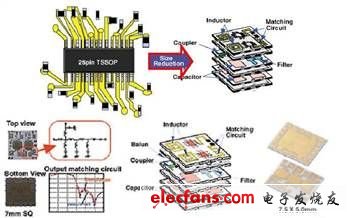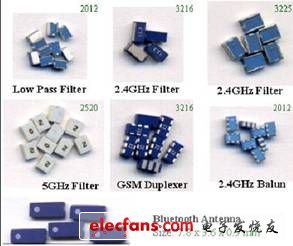1 Introduction to LTCC
This article refers to the address: http://
In the future, mobile phones are moving toward lighter, more versatile, digital, high-reliability, and high-performance. The miniaturization, integration, and modularization of components are becoming more and more urgent. Low Temperature Co-fired Ceramic (LTCC) is a remarkable multidisciplinary and integrated component technology that has emerged in recent years. It has played a huge role in driving the changes in the size and function of mobile phones. The role is a powerful means to achieve future mobile phone development goals. This technology was first developed by Hughes in the United States in 1982. The specific process is to make the low-temperature sintered ceramic powder into a precise and dense porcelain tape, which is used as a circuit substrate material on the green tape. Laser drilling, microporous grouting, precision conductor paste printing and other processes to produce the required circuit patterns, and buried multiple passive components (such as capacitors, resistors, filters, impedance converters, couplers, etc.) Then, they are laminated together and sintered at 900 ° C to form a passive integrated component of a three-dimensional circuit network. A three-dimensional circuit substrate with built-in passive components can also be fabricated, and ICs and active devices can be mounted on the surface thereof. Passive/active integrated functional modules.
  

Â
Figure 1 LTCC application in mobile phone transceiver module
Seeing such a complicated and professional explanation above, perhaps many people have begun to faint. In fact, literally, "low temperature co-fired ceramics" has already told everyone its basic meaning. First, it is made of ceramic materials; Secondly, the so-called "low-temperature co-firing" means that a plurality of layers of different functional ceramic sheets are stacked and fired at a relatively low sintering temperature (below 1000 ° C), and finally the required components are obtained. Someone has made an image metaphor for comparing components made of low-temperature co-fired ceramics to a building. Each layer has different functions, but they are a whole.
The amount of LTCC used in mobile phones is more than 80%. The LTCC products used in mobile phones include LC filters, duplexers, function modules, and transceiver switch function modules. The most common people are exposed to mobile phones, telephones, and cordless phones. The antennas used in Bluetooth headsets are now the most used. As long as the volume is small, the wireless receiving device must use filters and antennas, which are inseparable from the LTCC. The LTCC device is small in size, the smallest is only 1mm × 0.5mm, placed in the hand, a sneeze may not be seen.
  

Â
Figure 2 LTCC electronic components
2 Advantages of LTCC
Compared to other integrated technologies, LTCC has many advantages:
First, ceramic materials have excellent high frequency, high speed transmission and wide pass band characteristics. Depending on the ingredients, the dielectric constant of the LTCC material can be varied over a wide range. Combined with the use of high conductivity metal materials as conductor materials, it is beneficial to improve the quality factor of the circuit system and increase the flexibility of circuit design.
Secondly, it can adapt to the requirements of high current and high temperature resistance, and has better thermal conductivity than ordinary PCB circuit board. It greatly optimizes the heat dissipation design of electronic equipment, has high reliability, can be used in harsh environments, and prolongs its use. life;
Third, a circuit board with a high number of layers can be fabricated, and a plurality of passive components can be buried therein, thereby eliminating the cost of the package components, and implementing passive and active on a three-dimensional circuit substrate having a high number of layers. Integration helps to increase the assembly density of the circuit, further reducing the size and weight;
Fourth, it has good compatibility with other multilayer wiring technologies, such as the combination of LTCC and thin film wiring technology to achieve higher packing density and better performance of hybrid multilayer substrates and hybrid multi-chip components;
Fifth, the discontinuous production process facilitates the quality inspection of each layer of wiring and interconnecting vias before the finished product is manufactured, which is beneficial to improving the yield and quality of the multilayer substrate, shortening the production cycle, and reducing the cost.
Sixth, energy conservation, material saving, green, and environmental protection have become an irresistible trend in the development of the component industry. LTCC has also catered to this development demand, minimizing the environmental pollution caused by raw materials, waste and production.
3 LTCC application prospects
In addition to its application in mobile phones, LTCC has become the preferred method for integrating and modularizing electronic components in the future with its excellent electronic, mechanical and thermal characteristics. In the fields of military, aerospace, automotive, computer and medical, LTCC can obtain A wider range of applications. Although most of the current LTCC manufacturers are foreign companies, including Japan's Murata, Kyocera, TDK and Taiyo Yuden, CTS Corp and Robert Bosch GmbH in Europe. (Bosch), C-MAC MicroTechnology and Scrip-Erulec, etc. However, as far as the technical development of China's LTCC is concerned, there is no place for competition. The State Council issued the "Electronic Information Industry Adjustment and Revitalization in 2009". In the contents of the document of the Planning Outline, it is clearly stated that it will vigorously support the independent research and development of electronic components and set it as a key research field. The low-temperature co-fired ceramic technology will become a major development trend of China's electronics manufacturing industry in the next few years. Some domestic manufacturers have begun to install advanced LTCC equipment, and use self-developed new raw materials to accelerate the production and production of finished products. Many of them have developed a series of products such as Zhejiang Zhengyuan Electric Co., Ltd. and Shenzhen Nanpo Electronics Co., Ltd. A company with internationally advanced LTCC related products. Therefore, we believe that LTCC technology will bring revolutionary impact in China's electronic components industry.
usb cable, usb-c types, usb c charging cable, best charging cable for iphone, usb c cable
TOPNOTCH INTERNATIONAL GROUP LIMITED , https://www.mic11.com
